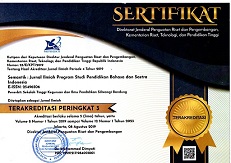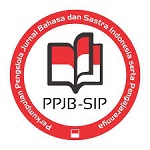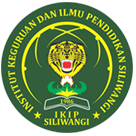STRUKTUR SEMANTIK ONOMATOPE BAHASA INDONESIA PENDEKATAN METABAHASA SEMANTIK ALAMI
DOI:
https://doi.org/10.22460/semantik.v13i2.p219-238Keywords:
Onomatopoeia, Natural Semantic Metalanguage, Semantic Structure, Indonesian VerbsAbstract
This research aims to describe the types of Indonesian onomatopoeia and describe the original meaning of Indonesian onomatopoeic verbs to be simple so that it is easily understood by cross-linguistic people. The method used is descriptive qualitative method. Data collection techniques by observing and recording data obtained from written media, such as textbooks and websites. The findings obtained from this research are that there are four types of Indonesian onomatopoeia, namely human voices, animal voices, natural sounds, sounds of various kinds of sound imitations. Some semantic structures of verbs show similarities and differences, namely differences in intention and desire from state verbs, process verbs, and action verbs. The semantic structures of calling verbs (piyaak-piyak-piyaak, ssshh-ssshh), stopping verbs (ti), and thumping verbs (bush-bush-bush) have purposive factors and desires. Similarly, the group of attacking verbs (eh hok hik, gludug-gludug, klontang, tet-tet-tet) have purposive and desirability factors. However, in the group of generating verbs (glug-glug-glug, uhuk-uhuk), falling verbs (bruk), and blowing verbs (whoosh) have no intentionality and are not purposive. The use of onomatopoeia has the benefit of creating a more vivid sound effect in the work so that readers can better feel the atmosphere of the story.References
Beratha, N. S. (2000). Struktur dan peran semantis verba ujaran bahasa Bali. In B.K. Purwo. (Ed.), Kajian Serba Linguistik: untuk Anton Moeliono, Pereksa Bahasa. BPK Gunung Mulia.
Chafe, W. L. (1970). Meaning and the Structure of Language. 1st Ed. University of Chicago Press.
Comrie, B. (1998). Aspect: An Introduction to the Study of Verbal Aspect and Related Problems. Cambridge University Press.
Cook, W. A. (1979). Case Grammar Development of the Matrix Model (1970– 1978). Georgetown University Press.
Effendy, O. U. (2008). Dinamika Komunikasi. Bandung: PT Remaja Rosdakarya.
Fitriana, Ita, Ni Luh S. B., I Wayan Pastika, I. N. S. (2021). Japanese Onomatopoeic Semantic Structures a Natural Semantic Metalanguage Approach. Psychology and Education Journal, 58(2), 4711–4720. https://doi.org/10.17762/pae.v58i2.2858
Frawley, W. (1992). Linguistic Semantics. Lawrence Erlbaum Associates.
Givon, T. (2001). Syntax An Introduction Vol. 1. John Benjamins Publishing Company.
Goddard, C. (1994). Semantic Theory and Semantic Universal. In C. W. A. Goddard (Ed.), Semantic and Lexical Universals: Theory and Empirical Findings. John Benjamins.
Goddard, C. (1997). The universal syntax of semantic primitives. Language Sciences, 19(3).
Goddard, C. (2010). Semantic molecules and semantic complexity. Review of Cognitive Linguistics, 8(1), 123–155. https://doi.org/10.1075/rcl.8.1.05god
Goddard, C. (2012). Semantic primes, semantic molecules, semantic templates: Key concepts in the NSM approach to lexical typology. Linguistics, 50(3), 711–743. https://doi.org/10.1515/ling-2012-0022
Keraf, Gorys.(1990). Linguistik Bandingan Tipologis. Jakarta: Gramedia.
Moleong, Lexy. 2007. Metodologi Penelitian Kualitatif. Bandung: Rosda
Mulyadi. (2008). Simbolisme Bunyi dalam Bahasa Indonesia. Fakultas Sastra Universitas Sumatera Utara Vol.32 No.3.p246-263.
Mulyadi. (2012). Verba Emosi Bahasa Indonesia dan Bahasa Melayu Asahan : Kajian Semantik Lintas Bahasa. Denpasar: Universitas Udayana
Ohala, J.J. (2007) “Sound Symbolism” dalam http://trill.edu/users/ohala/papers/SEOUL4-symbolism.pdf
Robertson, S. (1954). The Development of Modern English. Prentice Hall.
Sasti, P. M. (2020). Onomatope. https://balaibahasajateng.kemdikbud.go.id
Sujono. (1981). Arti Umum Kata-Kata yang Bernilai Onomatope dalam Bahasa Jawa Baru. Fakultas Sastra dan Kebudayaan UGM.
Sudaryanto. 2015. Metode dan Aneka Teknik Analisis Bahasa. Yogyakarta: Duta Wacana University.
Thomas, T. W. C., & Clara, C. H. W. (2004). Characteristics of Onomatopoeia. LIN101 Discovering Linguistics, 4(December), 22. https://www.academia.edu/7704080/Characteristics_of_Onomatopoeia_LIN1001_Discovering_Linguistics
Wierzbicka, A. (1996a). The Syntax of Universal Semantic Primitives. In C. Goddard (Ed.), Cross-Linguistics Syntax from a Semantic Point of View (NSM Approach),6-23. Australian National University.
Wierzbicka, A. (1996b). Semantics: Primes and Universals. Oxford: Oxford University Press.
Downloads
Published
Issue
Section
License
Copyright (c) 2024 Semantik

This work is licensed under a Creative Commons Attribution-ShareAlike 4.0 International License.
The author is responsible for acquiring the permission(s) to reproduce any copyrighted figures, tables, data, or text that are being used in the submitted paper. Authors should note that text quotations of more than 250 words from a published or copyrighted work will require a grant of permission from the original publisher to reprint. The written permission letter(s) must be submitted together with the manuscript.










